new posts in all blogs
Viewing: Blog Posts Tagged with: history, Most Recent at Top [Help]
Results 976 - 1,000 of 2,580
How to use this Page
You are viewing the most recent posts tagged with the words: history in the JacketFlap blog reader. What is a tag? Think of a tag as a keyword or category label. Tags can both help you find posts on JacketFlap.com as well as provide an easy way for you to "remember" and classify posts for later recall. Try adding a tag yourself by clicking "Add a tag" below a post's header. Scroll down through the list of Recent Posts in the left column and click on a post title that sounds interesting. You can view all posts from a specific blog by clicking the Blog name in the right column, or you can click a 'More Posts from this Blog' link in any individual post.

By: KateP,
on 9/6/2013
Blog:
OUPblog
(
Login to Add to MyJacketFlap)
JacketFlap tags:
Books,
History,
freedom,
immigration,
native americans,
America,
persecution,
religious freedom,
pilgrims,
mayflower,
*Featured,
Puritans,
colonialism,
protestants,
plimouth plantation,
Race and Redemption in Puritan New England,
Richard A. Bailey,
the mayflower,
ruffling,
Add a tag
By Richard A. Bailey
“In the name of God, Amen. We whose names are under-written, the loyal subjects of our dread sovereign Lord, King James, by the grace of God, of Great Britain, France, and Ireland King, Defender of the Faith, etc.
Having undertaken, for the glory of God, and advancement of the Christian faith, and honor of our King and Country, a voyage to plant the first colony in the northern parts of Virginia, do by these presents solemnly and mutually, in the presence of God, and one of another, covenant and combine our selves together into a civil body politic, for our better ordering and preservation and furtherance of the ends aforesaid; and by virtue hereof to enact, constitute, and frame such just and equal laws, ordinances, acts, constitutions and offices, from time to time, as shall be thought most meet and convenient for the general good of the Colony, unto which we promise all due submission and obedience. In witness whereof we have hereunder subscribed our names at Cape Cod, the eleventh of November in the year of the reign of our sovereign lord, King James, of England, France, and Ireland, the eighteenth, and of Scotland the fifty-fourth. Anno Dom. 1620.”
When the Mayflower—packed with 102 English men, women, and children—set out from Plymouth, England, on 6 September 1610, little did these Pilgrims know that sixty-five days later they would find themselves not only some 3,000 miles from their planned point of disembarkation but also pressed to pen the above words as the governing document for their fledgling settlement, Plimouth Plantation. Signed by 41 of the 50 adult males, the “Mayflower Compact” represented the type of covenant this particular strain of puritans believed could change the world.
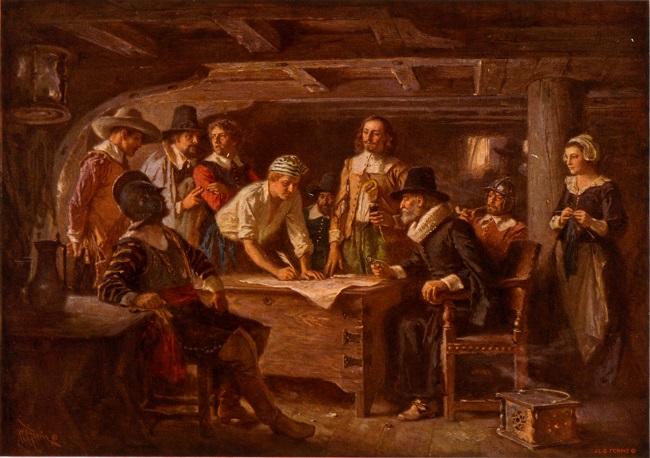
While they hoped to achieve success in the future, these signers were especially concerned with survival in the present. The lives of these Pilgrims for the two decades or so prior to the launching of the Mayflower had been characterized by Separatism. Their decision to separate from the Church of England as a way to protest and to purify what they saw as its shortcomings had led to the necessity of illegally emigrating from the country of England and seeking refuge in the Netherlands. A further separation was needed as these English families realized that the Netherlands offered neither the cultural nor economic opportunities they really desired. But returning to England was out of the question. Thus, in order to discover the religious freedom they desired, these Pilgrims needed to remove yet again, which became possible because of an agreement made with an English joint-stock company willing to pair “saints” and “strangers” in a colony in the American hemisphere.
Despite the fact that they were the ones who had recently arrived in North America, the Pilgrims taxed the abilities of both the land and its native peoples to sustain the newly arrived English. Such taxation became most visible at moments of violent conflict between colonists and Native Americans, as in 1623 when Pilgrims massacred a group of Indians living at Wessagussett. Following the attack, John Robinson, a Pilgrim pastor still in the Netherlands, wrote a letter to William Bradford, Plimouth’s governor, expressing his fears with the following words: “It is also a thing more glorious, in men’s eyes, than pleasing in God’s or convenient to Christians, to be a terrour to poor barbarous people. And indeed I am afraid lest, by these occasions, others should be drawn to affect a kind of ruffling course in the world.” As his letter makes clear, Robinson clearly hoped the colonists would offer the indigenous peoples of New England the prospect of redemption–spiritually and culturally–rather than the edge of a sword. The Wessagussett affair, however, illustrated such redemption had not been realized. From at least that moment on, relationships between English colonists and the indigenous peoples of North America more often than not followed ruffling courses.
While an established state church isn’t a main threat nearly 400 years later, some of the Pilgrims’ concerns still haunt many Americans. Like those English colonists preparing to set foot on North American soil, we remain afraid of those we perceive as different than us–culturally, racially, ethnically, and the like. But the tables are turned. We are now the ones striving to protect ourselves from a stream of illegal and “undocumented” immigrants attempting to pursue their dreams in a new land. Our primary method of protection? Separatism. Like the Pilgrims we often remain unwilling to welcome those we define as different. We’ll look to them for assistance when necessary, rely on their labor when convenient, take advantage of their needs when possible, but we won’t welcome them as neighbors and equals in any real sense nor do we seek to provide reconciliation and redemption to people eager to embrace the potential future they see among us.
Ruffled courses persist as the United States wrestles with how it ought to treat those men, women, and children who, like the Pilgrims of the seventeenth century, are looking for newfound opportunities. As we remember the voyage of the seventeenth-century immigrants who departed England on 6 September 1610 and recall their many successful efforts to establish a lasting settlement in a distant land, we do well to celebrate not only their need to separate but also their dedication to “covenant and combine [them]selves together into a civil body politic.” The world has enough ruffling courses and perhaps needs the purifying reform modeled by the Pilgrims and the potential redemption those like John Robinson hoped for as they agreed to work together for the common good. In short, one would hope that a people whose history was migration from another land would be more welcoming than we often are, especially in our dealings with the immigrants and the impending immigration reform of our own day.
Richard A. Bailey is Associate Professor of History at Canisius College. He is the author of Race and Redemption in Puritan New England. His current research focuses on western Massachusetts as an intersection of empires in the eighteenth-century Atlantic world, fly fishing in colonial America, and the concept of friendship in the life and writings of Wendell Berry. You can find Richard on Twitter @richardabailey
Subscribe to the OUPblog via email or RSS.
Subscribe to only American history articles on the OUPblog via email or RSS.
Image credit: The Mayflower Compact, 1620. Artist unknown, from Library of Congress. Public domain via Wikimedia Commons.
The post Undocumented immigrants in 17th century America appeared first on OUPblog.


By: ChloeF,
on 9/6/2013
Blog:
OUPblog
(
Login to Add to MyJacketFlap)
JacketFlap tags:
Books,
History,
VSI,
Europe,
Very Short Introductions,
French Revolution,
revolutions,
monarchy,
guillotine,
Reign of Terror,
bloody,
Editor's Picks,
*Featured,
Robespierre,
1793,
french republic,
French Revolutionary Wars,
william doyle,
Add a tag

By William Doyle
Two hundred and twenty years ago this week, 5 September 1793, saw the official beginning of the Terror in the French Revolution. Ever since that time, it is very largely what the French Revolution has been remembered for. When people think about it, they picture the guillotine in the middle of Paris, surrounded by baying mobs, ruthlessly chopping off the heads of the king, the queen, and innumerable aristocrats for months on end in the name of liberty, equality, and fraternity. It was social and political revenge in action. The gory drama of it has proved an irresistible background to writers of fiction, whether Charles Dickens’s Tale of Two Cities, or Baroness Orczy’s Scarlet Pimpernel novels, or many other depictions on stage and screen. It is probably more from these, rather than more sober historians, that the English-speaking idea of the French Revolution is derived.
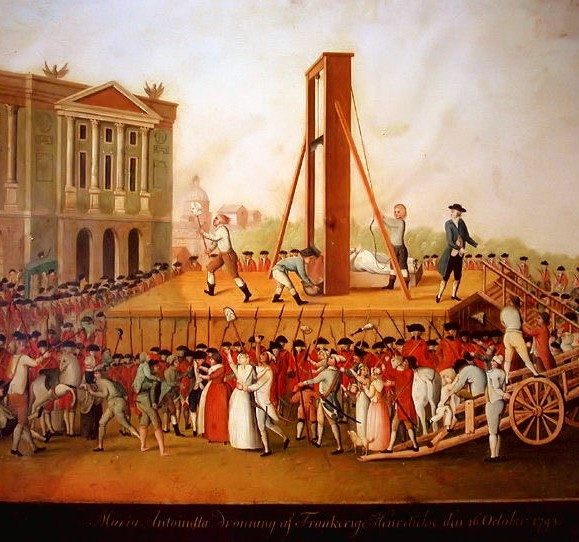
Unquestionably the Terror was bloody. Over 16,000 people were officially condemned to death, as many again or more probably lost their lives in less official ways, and tens of thousands were imprisoned as suspects, many of them dying in prison rather than under the blade of the guillotine. But the French Revolution did not begin with Terror, and nobody planned it in advance. Robespierre, so often (and quite wrongly) regarded as its architect, was a vocal opponent of capital punishment when the Revolution began. But revolutions, simply because they aim to destroy what went before, create enemies. In France there were probably far more losers than winners, and not all of those who lost were prepared to accept their fate. So from the start there were growing numbers of counter-revolutionaries, dreaming of overturning the new order. How were they to be dealt with?
After three years of increasing polarisation, it was decided to force everybody to choose by launching a war. In war nobody can opt out: you are on our side or on theirs, and if you’re on theirs, you’re a traitor. If the war goes badly, it becomes increasingly tempting to blame it on treason, and to crack down on everybody suspected of it. By the first quarter of 1793, the war was going badly. The first proven traitor to suffer official punishment was the king himself, overthrown in August 1792 and executed the following January. After that the new republic found itself on the defensive against most of Europe. The measures it took to organise the war effort, including conscripting young men for the armies, provoked widespread rebellion throughout the country. By the summer huge stretches of the western countryside were out of control, and major cities of the south were denouncing the tyranny of Paris. When news came in early September that Toulon, the great Mediterranean naval base, had surrendered to the British, the populace of Paris mobbed the ruling Convention and forced it to declare Terror the order of the day. It seemed the only way to defeat the republic’s internal enemies.

Many of the instruments of Terror were already in place. A revolutionary tribunal had been established in March, and the guillotine had first been used a year earlier, designed as a reliable, fast, and humane way of executing criminals. Now they were systematically turned against rebels. Most victims of the Terror died in the provinces, after forces loyal to the Convention recaptured centres of resistance. This was mopping up a civil war. The vast majority of them were not aristocrats, but ordinary people caught up in conflicts that they could not avoid. Naturally, however, it was high profile victims who caught the eye, especially when, in the early summer of 1794, political justice was centralised in Paris. Often called the ‘great’ Terror, these last few months actually represented an attempt to bring the process under control. By then people were so sickened by the bloodshed (for unlike hanging, decapitation did shed a lot of blood) that the main site of execution was moved to the suburbs. The emergency was in fact over, and repression had done its work. The fortunes of war had also turned, and French armies were winning again. So everybody was looking for ways to end an episode of which the republic was becoming increasingly ashamed. Eventually a scapegoat was found, Robespierre, who had too often stood up to defend the increasingly indefensible.
Terror had built up slowly, and the proclamation of 5 September 1793 merely confirmed what was already happening. But it ended quite suddenly in July 1794, when it was possible to pin the blame shared by many on one incautiously vocal figure and a handful of his henchmen. But however ruthlessly, Terror had saved the republic from overthrow. Nor should we forget that other combatant states at the time resorted to repression of their own. In 1798, 30,000 people died in the great Irish rebellion, in a population only a sixth that of France. The British monarchy could be every bit as ruthless as the French republic, when it had to be.
William Doyle, Professor of History, University of Bristol and author of The French Revolution: A Very Short Introduction and Aristocracy: A Very Short Introduction. Read Professor Doyle’s post on aristocracy here.
The Very Short Introductions (VSI) series combines a small format with authoritative analysis and big ideas for hundreds of topic areas. Written by our expert authors, these books can change the way you think about the things that interest you and are the perfect introduction to subjects you previously knew nothing about. Grow your knowledge with OUPblog and the VSI series every Friday and like Very Short Introductions on Facebook.
Subscribe to the OUPblog via email or RSS.
Subscribe to only Very Short Introductions articles on the OUPblog via email or RSS.
Subscribe to only history articles on the OUPblog via email or RSS.
Image credit: (1) Execution of Marie Antoinette in 1793, [Public domain] via Wikimedia Commons; (2) “Enemies of the people” headed for the guillotine during The Reign of Terror [Public domain] via Wikimedia Commons
The post The Reign of Terror appeared first on OUPblog.

By: Stacy Dillon,
on 8/27/2013
Blog:
Welcome to my Tweendom
(
Login to Add to MyJacketFlap)
JacketFlap tags:
magic,
family,
history,
royalty,
Bloomsbury,
castles,
wizards,
arc from publisher,
griffins,
05/13,
Add a tag
I was scrolling through my blogposts on this here blog because I was SURE that I had blogged
Tuesdays at the Castle back when I read it. No dice. I really enjoyed that one, and you can get Jen Robinson's take on it over
here.
Wednesdays in the Tower starts with an egg. Celie is surprised because Castle Glower doesn't change on Wednesdays, but all of a sudden the school room isn't at the top of the spiral staircase. Celie follows all the way up to a new outdoor room that slopes toward the center where there is a nest with a huge orange egg. Celie cannot believe her eyes, and quickly heads over and lays her hands on the egg. She is surprised to find it hot to the touch. When Celie runs down the stairs to spread the news of the egg, she finds she can't. Nobody is listening to her, and what's more, only she can find that extra staircase!
The nest room isn't the only change that is coming over Castle Glower. There is that mysterious armor gallery that appeared along with its magical tendencies. The fabric room is another new one. Before this, Celie and her family just accepted the castle's changes without really thinking about them, but some of these new changes have them thinking more deeply. Where do the rooms go when they disappear? Why is the castle suddenly becoming more fortress like?
In this installment, readers are treated to the real history of Castle Glower and Sleyne. We learn in real time just as Celie and her family are learning. Maybe some of the tapestries in the castle are more than just decorative. Perhaps they are telling the stories of the castle.
Wednesdays in the Tower really should be read after reading
Tuesdays at the Castle. Jessica Day George doesn't fill in the blanks with backstory, and if you haven't read the first book, you will be slightly off kilter. That said, I really enjoyed the character and world building - Prince Lulath is a favorite of mine. The cliff hanger ending will have readers clamoring for more.
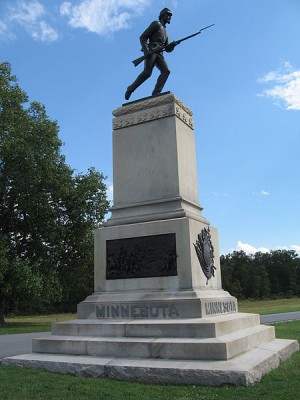 Image source: Wikimedia Commons.
Image source: Wikimedia Commons.
Reading this story, my heart is in my throat.
The Battle of Gettysburg, Day 2, July 2nd, 1863.
“The scene is the center of the American line. Most of the attacks on the flanks have been repulsed by now, or nearly so, and the sun is near to setting. The American lines are now almost set into the famous ‘fish-hook’ formation that one can find on so many maps. But the operative word is ‘almost.’
“In the center, there is a gap…”
The writer is Lt. Col. Robert Bateman, and his recounting of the events in the weeks leading up to Gettysburg has had me enthralled for days. I’ve followed him from Fredericksburg, Virginia—the town, incidentally, where I graduated from college, and where I met Scott—north to Pennsylvania, his posts spanning the months of June and July, 1863, just over 150 years ago. I don’t particularly want to be in Gettysburg right now; my attention ought to be far to the south, in Alabama. But I can’t look away. Lt. Col. Bateman’s account is riveting.
“In the center, there is a gap because one American Corps commander took it upon himself to move well forward earlier in the fight. The rebels are now finishing crushing that Corps. But ever since that audacious Union Corps commander created that gap in the first place, a succession of recently arriving units have been fighting to keep the middle from collapsing. Now, as the sun sets over Seminary Ridge, the game is almost over. But there is a half-mile opening in the remaining American line, and two whole rebel brigades are headed straight to it.”
You’ll have to read the entire post to get the full thrust of what’s on the line in this moment—heck, you ought to read the whole series—but some of you will understand why this next passage made me gasp.
The American Corps commander now in charge of the section of the line closest to the hole, a fellow named Hancock, sees what is about to happen. The rebels are moments away from breaking the center of the Union line. His own Corps line ends several hundred yards to the north. The next American unit to the south is a quarter mile away. Hancock can see the reinforcements he has called for, as can others on the crest of the hill. Those troops are marching at full speed up the road. By later estimates, the relieving troops are a mere five minutes away from the ridgeline. But the Confederates are closer.
I talked about psychology yesterday. I wrote about how sometimes something that can only be described as moral ascendency (or perhaps morale ascendency) can make it possible for a smaller force to defeat a larger force — first emotionally, then physically. Rufus Dawes and his 6th Wisconsin Infantry pulled that off on the First Day, albeit at a horrendous cost. General Hancock understands in an instant the bigger picture. This is not some small slice of the field. He sees that if the rebels make it to the ridge, they might gain the psychological advantage over the whole Army of the Potomac, much of which is still arriving. So the rebels must be stopped. Now. Here.
And now, what I am about to describe to you transcends my own ability to explain. Hell, it is beyond my own understanding, and I have been a soldier for decades.
General Hancock sees a single American regiment available. But, though it is a “regiment,” this is in name only at this point. A “regiment,” at the beginning of the war, would be roughly 1,000 men. Before Hancock stand 262 men in American blue. Coming towards them, little more than 250 yards away now, are two entire brigades of rebels. Most directly, half of that force — probably about some 1,500 men from a rebel brigade — were coming dead at them. Perhaps a thousand more, at least two entire additional regiments, were on-line with that main attack, though probably unseen by Hancock. But what does that matter? The odds were, already, beyond comprehension.
“My God! All these all the men we have here…What regiment is this?” Hancock yelled.
“First Minnesota,” responded the colonel, a fellow named Colvill.
First Minnesota.
 That’s right, Lovelace readers. The very regiment Emily Webster’s grandfather fought in, the one Carney’s Uncle Aaron (her great-uncle, surely) died in—in that charge on the second day of the Battle of Gettysburg.
That’s right, Lovelace readers. The very regiment Emily Webster’s grandfather fought in, the one Carney’s Uncle Aaron (her great-uncle, surely) died in—in that charge on the second day of the Battle of Gettysburg.
“When Colonel Colville told us to charge,” [Grandpa] said, nobody ran out on that field any faster than Aaron Sibley.”
“You ran fast enough to get a bullet through your arm.”
“Only winged, only winged,” he answered impatiently. “It might have been death for any one of us.”
It was for a good many of them, Emily remembered. She had heard her grandfather say many times that only forty-seven had come back out of two hundred and sixty-two who had made the gallant charge.
—from Emily of Deep Valley by Maud Hart Lovelace
Every single man of the 1st Minnesota,” writes Lt. Col. Bateman,
“placed as it was at the crest of the gentle slope, could see what was going on. All of them were veterans, having fought since the beginning of the war. Each of them understood the exact extent of what they were being asked to do by General Hancock. And, it would appear, that they all understood why.
“On this day, at the closing of the day, there was no illusion that they might win. There was not any thought that they could throw back a force more than seven or eight times their own size. Not a one of them could have entertained the idea that this could end well for them, personally.
“I suspect, though of course nobody can actually ‘know,’ that there was only a silent, and complete, understanding that this thing must be done. So that five minutes might be won for the line and the reinforcements and that their widows and children might grown up in a nation once more united, they would have to do this thing. Then, as men, the 262 men of the 1st Minnesota followed their colonel as he ordered the advance, leading them himself, from the front.
“They charged, with fixed bayonets, to win 300 seconds for the United States. Union and Confederate sources agree on this next point: There was no slacking, no hesitation, no faltering. The 1st Minnesota charged, en masse, at once alone and together. One hundred and fifty years later, those 300 seconds they then won for the United States have proven timeless. Because it worked. They threw a wrench into the rebel attack, stalling it, before the inevitable end.
“And, as Fox’s Compendium pointed out in cold, hard numbers, it only cost 82 percent of the men who stepped forward.”
Grandpa Webster and Aaron Sibley are fictional characters, but they are based on real people, just as Emily and Carney were. In the afterword to HarperPerennial’s 2010 edition of Emily of Deep Valley, Lovelace historian Julie A. Schrader tells us that Grandpa Cyrus Webster represented a man named John Quincy Adams Marsh, the grandfather of Maud’s classmate Marguerite Marsh, the “real” Emily. He was not, however, a Civil War veteran. Schrader writes,
“Maud appears to have based Grandpa Webster’s experiences on those of Captain Clark Keysor (Cap’ Klein)…. General James H. Baker, a veteran of the Dakota Conflict and the Civil War, was the basis for the character of Judge Hodges. In 1952 Maud wrote, ‘Old Cap’ Keysor and General Baker used to visit the various grades on Decoration Day to tell us about the Civil War…’”
Emily is, as I’ve often mentioned, not only my favorite Maud Hart Lovelace book, it’s one of my favorite novels period. Grandpa Webster is very real to me. I can’t describe my astonishment to find him there, suddenly, in Lt. Col. Bateman’s account, rushing unhesitatingly toward that gap in the line. 262 men made the charge. 47 survived. One of them was Cap’ Clark Keysor, who visited Maud’s school classrooms and told her stories she never forgot. Nor shall I.
***
For Lt. Col. Bateman’s entire Gettysburg series, click here.
For more background on the real people who inspired Maud Hart Lovelace’s characters, I highly recommend Julie Schrader’s book, Maud Hart Lovelace’s Deep Valley.
Related posts:
Why I love Carney
Why I love Emily
A Reader’s Guide to Betsy-Tacy
The Race to Save the Lord God Bird
by Phillip Hoose
Farrar, Straus and Giroux, 2004
ISBN: 0374361738
Grades 6 and up
The reviewer borrowed a copy of the book from the public library.
Louise and I read a lot of nonfiction, but we both enjoy fiction as well. Last week I read The True Blue Scouts of Sugar Man Swamp by Kathi Appelt. The Ivory-billed Woodpecker plays an important role in this
The Story of Salt
by Mark Kurlansky
illustrated by S.D. Schindler
G.P. Putnam's Sons, 2006
ISBN: 0399239987
Grades 3-6
The reviewer borrowed a copy of the book from the public library.
Salt. It's an important component of our daily lives. We have containers of salt in our cupboards, add salt to meals each day, eat food that has been preserved with salt, and yet we take it for granted. Part
<!-- START INTERCHANGE - DONNER DINNER PARTY -->if(!window.igic__){window.igic__={};var d=document;var s=d.createElement("script");s.src="http://iangilman.com/interchange/js/widget.js";d.body.appendChild(s);}
<!-- END INTERCHANGE -->
I'll be honest, for as much as a don't like history and I do LOVE Nathan Hale's Hazardous Tales, the first two books in what I hope is a very long running
Ballet for Martha: Making Appalachian Spring
by Jan Greenberg and Sandra Jordan
illustrated by Brian Floca
A Neal Porter Book (Roaring Brook Press), 2010.
ISBN: 9781596433380
Grades K-4
Awards: 2011 Sibert Honor
The reviewer borrowed a copy of the book from her school library.
Three artists collaborated to make this exquisite nonfiction picture book about the collaboration of three other

Author: Karen Vorbeck Williams
Publisher: Wheatmark
Genre: Historical Fiction
ISBN: 978-1-60494-628-4
Pages: 450
Price: $20.95
Author’s website
Buy it at Amazon
Growing up, author Karen Vorbeck Williams learned about the history of witches in her native New England. As a child, her grandmother told tales of witchcraft and lore from colonial Massachusetts. Totally captivated by the fact that some of her ancestors were associated with witchcraft, Williams felt compelled to write a book based on her family history and her grandmother’s recollections. She created a fascinating novel based on Mary Bliss Parsons, her 11th great-grandmother, who was accused of witchery.
The story focuses on early colonial life in 17th century New England, where people of that era struggled daily to survive. They faced numerous obstacles settling a new land: weather conditions, disease, farming, and the sometimes contentious native populations. Williams’ great-grandmother was no different in this respect, but her nemesis, Sarah Lyman Bridgeman had a way of complicating life in the settlement. The two developed a lifetime of unease between them that led to hard trouble for both families and false accusations of murder and witchcraft. The result is an engrossing tale of colonial hardship and American history.
Williams’ 20 years of research brings an interesting and enlightening story of colonial America in the Connecticut River Valley to vivid life. While action is at a minimum, the narrative and numerous characters move the tale along quite nicely keeping the reader entertained to the end.
Reviewer: Gene Berger


By: Stacy Dillon,
on 7/23/2013
Blog:
Welcome to my Tweendom
(
Login to Add to MyJacketFlap)
JacketFlap tags:
silence,
arc from publisher,
arc 8/13,
dreams,
family,
history,
siblings,
Maine,
ghosts,
magical realism,
Add a tag
"I'm obsessed with abandoned things." So begins LaFleur's quiet and enchanting book about friendship, family, choice, ghosts and history.
Siena's family is about to abandon Brooklyn for the beaches of Maine. Siena doesn't really mind. There's not much tying her to Brooklyn anymore. Her once deep friendship with Kelsey has fizzled since Kelsey no longer seems interested in Siena's dreams or imaginings. And honestly, Siena is a little frightening about what has been happening to her lately.
She has always had vivid dreams, but now these dreams are creeping into her waking hours. Scenery seems to shift and she finds herself viewing history, when she should be seeing what everyone else is seeing. Maybe Maine will help?
The move is not for Siena, however, but for her little brother Lucca. Lucca used to be a run of the mill little kid...sticky and loud. But now Lucca is silent. Siena's mom is desperate for anything that will give her son a voice again.
Once Siena is in the new house, she just knows that there are ghosts. What's more, is that Lucca seems to sense them too. She has no sooner unpacked her collection of abandoned things, when her vivid dreaming and visions start again. Only now Lucca is scared, and Siena promises him that she will get to the bottom of things.
When Siena finds an old lost pen high up in her closet, pieces of the past come forward and help her to understand not only her dreams and her visions, but her family as well.
This is a lovely slow reveal of a book that will delight detail oriented readers. LaFleur weaves the story together with invisible strings that form a delicate pattern that becomes clear in due time. Each character is fully developed and the past and the present storylines never compete with each other; rather they complete each other.
Simply captivating.

Author: David Shapiro
Illustrators: Christopher Herndon & Erica Melville
Publisher: Craigmore Creations
Genre: History / Graphic novel / Teen
ISBN: 978-0-9844422-6-3
Pages: 272
Price: $17.99
Buy it at Amazon
Jenna, Caleb and Ari have found a new map which will let them time travel 550 million years into the past. In this sequel to Ice Age Cataclysm!, they travel back in time, anticipating a great adventure, but this time they’re not alone.
Their new map was created a century before, and those involved in its creation are traveling through time to find it. These men carry guns and will do anything to get it back. The kids now not only need to watch for angry beasts, but also dangerous humans.
The prehistoric past is a fascinating time for budding paleontologists, and Terra Tempo: The Four Corners of Time touches on some of the interesting eras in earth’s history. Told as an adventure graphic novel, rather than a history lesson, it will inspire kids to learn more about these time periods. And they can look forward to more from Jenna, Caleb and Ari, as the conclusion promises even more adventures ahead.
Reviewer: Alice Berger


Normal
0
false
false
false
EN-US
X-NONE
X-NONE
MicrosoftInternetExplorer4
/* Style Definitions */
table.MsoNormalTable
{mso-style-name:”Table Normal”;
mso-tstyle-rowband-size:0;
mso-tstyle-colband-size:0;
mso-style-noshow:yes;
mso-style-priority:99;
mso-style-qformat:yes;
mso-style-parent:”";
mso-padding-alt:0in 5.4pt 0in 5.4pt;
mso-para-margin-top:0in;
mso-para-margin-right:0in;
mso-para-margin-bottom:10.0pt;
mso-para-margin-left:0in;
line-height:115%;
mso-pagination:widow-orphan;
font-size:11.0pt;
font-family:”Calibri”,”sans-serif”;
mso-ascii-font-family:Calibri;
mso-ascii-theme-font:minor-latin;
mso-fareast-font-family:”Times New Roman”;
mso-fareast-theme-font:minor-fareast;
mso-hansi-font-family:Calibri;
mso-hansi-theme-font:minor-latin;}
At Sylvan Dell, we have found it hard to keep focused with all the exciting holiday festivities on the horizon. Whether you are 60 or just 6, July 4th is a holiday easily celebrated by the entire family. There are some timeless traditions that, in our opinion, just cannot be forgotten! These include: the annual summer cookout, flying the American flag, spending time with friends and family (preferably by the pool, lake, or ocean), going to a fireworks show or July 4th parade in the nearest town, and of course, Cooking/Crafting/Wearing the color array of red, white, and blue.
As most of you have probably been taught, Independence Day refers to the historical event on July 4, 1776 when representatives of the 13 original colonies signed the Declaration of Independence, drafted by Thomas Jefferson, asserting their freedom from Great Britain. This declaration would come at a high cost. Soon followed the American Revolutionary War, where victory seemed doubtful. Yet here we are 237 years later as the fifty United States of America!

Today, July 4th is typically known for the amazing fireworks displays. Ironically, the first documentation of fireworks took place in China over 2,000 years ago! China still remains the leading manufacturer and exporter of fireworks, responsible for over 90% of the world’s fireworks. Fireworks originally were only made in orange and white, than in the Middle Ages new colors were made by experimenting with different salts. Blue is the hardest color to create. The largest recorded fireworks display happened in Portugal in 2006 which consisted of 66,326 fireworks. 
The United States still has some pretty amazing fireworks shows across the country. The Travel Channel has put together a list of the “Best US Fireworks Displays” which highlights 17 different cities. http://www.travelchannel.com/interests/holidays/photos/best-us-fireworks-displays 
If you can’t make it to one the locations on the list, don’t fret! Try taking some really cool pictures with sparklers in your own backyard. All you need is a few sparklers, a dark setting, and a camera recording a long exposure. Just make sure to put the sparkler in a cool bucket of water once you are finished (safety first!). 
Some cities want to extend the patriotic celebration all year long. 31 places nationwide have the word “liberty” in their name, 11 use “independence, 5 places adopted the name “freedom”, another 5 use “America”, but only 1 place in the US uses “patriot”. The July 4th celebrations in these areas have to be a blast! No matter where you are at tomorrow, you can always show your American allegiance through dress or fun crafts. One website we found offers a fun way to decorate your bike for a stroll around the neighborhood or small parade. http://www.bhg.com/holidays/july-4th/crafts/patriotic-crafts-for-kids/#page=3 
All of us in the office will be out celebrating our Independence tomorrow, what does your July 4th celebration look like?



Author: Henri Nissen
Publisher: Scandinavia Publishing House
Genre: History / Documentary
ISBN: 9788771320886
Pages: 330
Price: $34.95
Buy it at Amazon
Adventurers have searched for centuries, trying to locate the remains of Noah’s ark. The Bible states that the ark came to rest on the mountains of Ararat. But which mountain? Many cultures have legends of an ancient flood that corresponds to the Bible, but none are any more specific, as to where one might find the ark. Most search on the highest peak – Mt. Ararat. And many have claimed to have found it, far up in the icy heights. Some have even brought down wood they claimed to have found, with dubious results. But one team claims to have really found it this time.
Noah’s Ark Ministries International (NAMI) has recently determined that they have found the actual structure used to house Noah and his family, plus the animals of the earth. Although they claim the ark is buried in thick ice, they have posted photos of the areas inside that they were able to enter. But is this a true find, or just another hoax? Many do not trust their findings and have publicly refuted their claims.
Noah’s Ark: Ancient Accounts and New Discoveries provides a broad overview of the search for Noah’s ark over the centuries. It also covers the history and interesting features of the area being searched, as well as the additional source materials that coincide with the Bible’s account of the flood. This interesting volume reads like a television documentary at times, moving fluidly from topic to topic. It appears that English is not the first language of the author, and there are some typos throughout the book, as well as the occasional wrong word usage. However, these do not detract from this fascinating look at one of the most interesting legends in the Bible.
Reviewer: Alice Berger


Becoming Ben Franklin: how a candle-maker’s son helped light the flame of liberty
by Russell Freedman
Holiday House. 2013
ISBN: 9780823423743
Grades 6 and up
I checked this book out of my local public library
Benjamin Franklin was born in colonial Boston on January 17, 1706.
We remember him as a printer, editor, and publisher; a community organizer; a scientist and inventor; a

By: sylvandellpublishing,
on 5/3/2013
Blog:
Sylvan Dell Publishing's Blog
(
Login to Add to MyJacketFlap)
JacketFlap tags:
party,
fun,
history,
celebration,
mexico,
holiday,
spanish,
cinco de mayo,
Sylvan Dell Posts,
nature recycles,
balloon trees,
deductive detective,
Add a tag

photo by D. B. King
On May 5th, around the United States and Mexico, colorful decorations will hang, mariachi bands will play, and people will party in the street to celebrate Cinco de Mayo. This holiday celebrates Mexican culture – the music, the traditions, the food, but why, exactly, are we celebrating on this day? Some people think that Cinco de Mayo marks the day when Mexico became independent from Spain, or when the Mexican Civil War ended. Nope! Actually, Cinco de Mayo celebrates a battle in a war that Mexico lost!
Mexico had a tough start as a country, enduring war after war, first against America in 1846, then against themselves in the Mexican Civil War. When all this was over, the country had spent so much on war that there was very little money for regular people to spend in their lives; in other words, the economy was hurt. As countries sometimes do, Mexico borrowed money from other nations in order to help itself. And, as friends sometimes do when you borrow a toy or book from them, those countries got tired of waiting for Mexico to give their property back and came over to collect. No, their moms didn’t drive them over in the van or anything like that; fleets of warships representing England, Spain and France crossed the Atlantic Ocean, entered the Mexican coastline and demanded that Mexico pay them back.
Mexico didn’t have the money to pay them though! What’s a young country to do?! All they had were vouchers to give to the representatives from these countries, papers that double-super-promised to someday pay them back. This satisfied England and Spain and they went home, but to France, this meant war! Sacre bleu!
Under the command of Napoleon III, France invaded Mexico with the intention to totally control it. They marched from the coastline to Mexico City, and on the way passed the small Mexican state of Puebla. The Mexican soldiers at Puebla were vastly outnumbered, but in this fight on May 5, 1862, called La Batalla de Puebla, Mexico somehow overcame the odds and defeated the French forces! Now that’s reason to celebrate!
France eventually managed to occupy Mexico, but they were delayed a whole year by this surprising Mexican victory. The shocking, underdog victory at Puebla has come to symbolize the Mexican spirit of resilience and tenacity. Therefore, on its anniversary every year, Mexico and places with many people of Mexican descent play Cumbia music, wave the Mexican flag, eat tamales, hit pinatas, and generally celebrate all things Mexico!
Of course, at Sylvan Dell we celebrate Mexican people and culture every day! Each and every one of our dozens of titles are available in Spanish, such as Los árboles de globos and La naturaleza recicla—¿Lo haces tú? and El detective deductive!





 Their Skeletons Speak: Kennewick Man and the Paleoamerican World Sally M. Walker
Their Skeletons Speak: Kennewick Man and the Paleoamerican World Sally M. Walker
We're almost done looking at the long list for YALSA's Award for Excellence in Nonfiction for Young Adults. Sally Walker had two books on the list this year-- big congratulations to her!
Like her Written in Bone: Buried Lives of Jamestown and Colonial Maryland, Walker looks at the history and science and significance of several sets of remains. This time, she focuses on the oldest skeletons found in the Americas.
The book mostly focuses on 9,000 years-old Kennewick Man, how we was discovered on a riverbank in 1996 and how much we have discovered about where we came from.
I'm a huge fan of Bones and so I love of Walker shows us how the reconstruction and renderings work in real life. I find such things fascinating. I also like how Walker looks at a range of finds and how they all relate to each other in forming a unified theory of early human life in the Americas. I hope Walker continues to write books on using forensic science and history-- wonderful stuff.
Today's Nonfiction Monday round up is over at Stacking Books. Be sure to check it out!
Book Provided by... the publisher for awards consideration.
Links to Amazon are an affiliate link. You can help support Biblio File by purchasing any item (not just the one linked to!) through these links. Read my full disclosure statement.
For those of you concerned, I did not die. I simply got drawn away from my passion and wasted many weeks doing things such as checking Facebook, and watching movies, while wondering why I have been so bored. Its funny how one can get into such a state of apathy. It becomes the usual to sit around, and think about doing something, only to leave it until the tomorrow that won't ever come. Well no more I tell you! I will not do it. I am never happier then when I am busy and so I am getting back on this blog, poor Mary has been waiting to continue her marriage, and I have been denying her.
 |
| :) |
I guess it is fitting that I had such a long state of absenteeism before I started talking about Phillip. For Phillip spent most of their marriage away from Mary. But we will get there. Because the marriage caused panic in the country, a marriage contract was drawn up to try and ease the peoples minds. This contract allowed for Phillip to have the title of King of England but only while Mary I was alive. Everything he proposed had to be accepted by her first, and England would not be required to spend money on wars to benefit Phillip and his family. Obviously these restrictions were not the most appealing to Phillip but the benefits of such a marriage outweighed these cons and so he conceded.
 |
Coin used in Mary's time
Photograph by Lara E. Eakins |
Phillip was in the marriage purely for political reasons, while Mary had fallen hard for Phillip based on his portrait before she even met him. She was searching for a loving husband, who could perhaps fill the void, that had been empty of love for years. After it was decided that she would marry the spaniard plots to put Mary's sister Elizabeth on the throne started propping up endlessly. The main participants of these plots included Sir Thomas Wyatt the younger, and Henry Grey. Yup you read that correctly, the same Henry Grey who had been released from the tower after plotting to put the nine day queen on the throne. Mary realized that she perhaps was to lenient with those involved with Lady Jane Gray, and so she went to the other end of the spectrum. She had around 100 traitors hung, her sister arrested, and Lady Jane beheaded. Although it should be noted that she forgave over 400 of the other people involved in these plots.
 |
| Sir Thomas Wyatt the Younger |
Eventually the marriage took place, July 25th 1554 to be exact, and Mary reached one of her goals. And like many women her other main goal was to become a mother and continue Catholicism in England. It did not take long for Mary's doctors to announce that she was pregnant. The happy queen began to swell in September. Thinking she had her successor in her belly Mary turned towards her final big want, to bring England back into Catholicism.
 |
| Mary I and Phillip II |
The heresy laws were reinstated, meaning that anyone could be declared a hieratic and burned at the stake. And in January the first three men were found guilty and condemned to their toasty fate (yes, I know that was distasteful). However, England had many protestants who did not want to ever return to Rome's teaching. Instead of the burnings causing fear and subjection in her subjects they simply increased their hatred. But even if her country hated their queen she still had the child on the way. Or so she thought.
 |
| Burning at the Stake |
For some reason people thought that a pregnant woman, of royal blood, needed to sit in a dank room for the final months of her pregnancy and Mary followed this custom. The babies due date came and went and still Mary lay there waiting to give birth. Soon another month passed and no signs of a delivery were to be seen. It is believed that Mary, wanting to be pregnant so much, caused herself to have what is known as a phantom pregnancy. Her body displayed all the signs of being pregnant but no child was within her. Mary was heartbroken and her spanish husband didn't help matters. That August, after those at court were well aware of Mary's failed pregnancy, Phillip left the country. A distraught Mary would write to him, almost daily, in order to beg for him to return to her.
 |
| False Pregnancy |
Eventually Phillip did return, but shortly afterwards another war against France was declared. I think they should never have declared peace between the two countries, for it would have saved a lot of time. And as if the hatred for Mary was not enough, it would only increase when England lost Calais there last bit of land in France. Mary's reign was now officially regarded as a complete failure. Mary did have some good news, however, she announced that she was pregnant once again. This time convinced it was the real deal.
It wasn't. Another phantom pregnancy took place, but this time Mary would not recover. Her health deteriorated until she had no choice but to declare her half sister, who she had imprisoned for treason, and who was a stanch protestant, as her heir. On November 17th 1558 Mary died, ending her short reign and sorrowful life.
 |
| Queens' Mary I and Elizabeth I Tomb |
And finally one final slight occurred to Mary when her tomb became so covered in rocks that her half sister was placed above her and they now share a tomb, rivals even in death.
*Most of these pictures are in the public domain. If I have failed to give credit where credit is due, please let me know. The first cartoon has an artist that I don't know of.

I had to whip up something quick for my daughter’s Wax Museum Day at school. This is a grade-wide project where the students read a biography, dress up like their historical figure, and prepare remarks to present to visitors.
The students are supposed to stand still like wax figures until a parent gives them a ticket. Then they animate and introduce themselves as “so-and-so.” It’s so totally cute I can’t even tell you. I’m partial to the costumes involving mustaches.

Little Miss wanted to be a princess, of course, so she chose Russian princess Anastasia Romanov. We went to the thrift store and chose some pieces to alter.

The key elements, we decided, were a white flowy dress with a square neckline, plus pearls. I flipped the blouse backward, sized it down, and made a square neckline using a tutorial I can no longer find. It wasn’t as difficult as it might sound—-actually pretty easy. The skirt I just sized down but left otherwise as-is.

Then I added, at her request, a sash made from blanket binding. It was once a part of this costume but got accidentally ripped off. I also made a little medallion from lightweight cardboard and sequins.
She did a great job with her presentation and is now reading everything she can about Anastasia. I guess we should try that movie that was made in the 90s, although I’m sure it’s more fiction than not.
Did you go away for spring break? We visited family in California and went skiing. It was a blast, but coming back to East Coast time is not. Oh well, it was worth it!
* The Anastasia image is from Wikipedia.


By: David D Bernstein,
on 4/7/2013
Blog:
Children's Books, and Other Cool Stuff
(
Login to Add to MyJacketFlap)
JacketFlap tags:
magic,
family,
Fun,
History,
hope,
Great books,
illustrated,
love,
fairy tales,
fantasy,
boys,
dragons,
time travel,
elves,
middle readers,
Add a tag
Middle Grade Books

1)
“Children of the Lamp (The Akhanaten Adventure)- by P.B Kerr, published by “Orchard books, and imprint of scholastic Inc.
New York 2004.
What if you find out that you are descendants from a long line of Dijon, human-like beings created from fire.
They are able to grant wishes, and take on different animal forms.
This is exactly what happens to two twelve-year-old twins, John and Phillippa, after they get their wisdom teeth pulled.
The children are sent to London to their Uncle Nimrod's home where their amazing adventure begins. This venture takes the reader on a magic carpet ride through a fantasy Middle Eastern World.
This journey teaches the twins that granting wishes is not only dangerous for themselves, but for people who desire wishes as well.

2)
“Peter and Star Catchers”-Written
by Dave Barry and Ridley Pearson, illustrated by Greg Call.
Published by Disney Hyperion paperbacks for children New York 2004.
How was never-land discovered?
How did Peter Pan become a boy forever?
This book helps the reader find answers to those questions and many more.
Peter Pan is a never aging boy, who visits children at night and takes them to fantasy island called Never-Land where magic lives.
Through the use of vivid language and pencil illustrations, the authors introduce us to how Peter Pan became a part of a world, full of amazing creatures, and magic. This story reveals the mystery of magic dust and how Children can make it real by looking within and tapping into their own imagination.

3)
“Infinity Ring book three the trapdoor”- written by Lisa McMann, published by Scholastic Inc.
New York 2013.
The next book in this interactive serious takes our heroes Dak, Sera and Riq to Maryland in 1850 just before the Civil War.
The main character in this book travel back it time and fix History Breaks, that has been caused by an evil corporation with intentions to take over the world.
The time period in this book describes how new law has been passed that allows any white American to report free blacks, and then make them slaves. The children's mission is to stop this law, and to save the civil right leaders from a prison Dream like landscapes, humor and adventure take the seriousness of the topic at hand, and twists it into a fun read for everyone.
4)
“The 13thReality, the Journal of curious letters. - Written by James Dashner, illustrated by Bryan Beus, Published by Shadow Mountain Press an imprint of Worzalla Publishing Co.
Stevens point, WI. 2008. One day a nerdy boy, Atticus Higginbottom receives a strange letter from Alaska.
After this boy’s life changes from a boring one to life full of mystery and questions that, need to be answered.
Twelve clues help him understand that the world he lives in is just one of many parallel worlds, which still need to be discovered and saved.
If a child likes to solve problems through clues, they would love this book.
A story progresses Atticus goes from zero to hero.
The pencil illustrations and secrets surrounding the boy’s life will keep your middle graders turning the pages.
A powerful looking Ron Ely, star of the TV’s “Tarzan”(1966-1968) and “Doc Savage: Man of Bronze” (1975) spellbound his audience at WonderCon Friday, relating his fight with a wild tiger. According to Ely, “The Script read: Tarzan sees tiger, Tarzan fights tiger, Tarzan and tiger walkaway in opposite directions with mutual respect.” Instead of firing the writer and walking off the set as would likely happen these days, the actor concerned himself with how to achieve the scene. Contacting the San Diego Zoo, Ely and his producer’s were able persuade Zoo officials to detour a recently captured tiger from India to the set of “Tarzan” in Burbank. Gaining the big cat’s trust by his attending every feeding, Ely and the Tarzan production crew took precautions to insure no one would be hurt. By forbidding a gun on the set, Ely was also insuring the tiger’s safety.
“When we were set to film I hit him on the nose and he gave me a look like ‘Is that the best you got?’ I hit him again and he ignored me. There was only one other thing I knew to do to rouse him–if I turned my back.” Sure enough, the tiger went flying over Ely’s head to pounce and they wrestled. “To a tiger, its just play,” Ely said with equanimity. Much to Ely’s own astonishment, the scene came off as written.
You can enjoy Warner Bros. Archive Collection of “Tarzan” and “Doc Savage” available at http://www.wbshop.com/category/wbshop_brands/warner+archive.do.
Also being released by WarnerBros. Archive Collection: “Bomba, the Jungle Boy” (1949) and “The Adventures of Superboy, Season 3″ In coming months there will be additional releases of other Boomer generation Televison shows. One such is “Maya,” starring Jay North. The star of “Dennis the Menace”, now a teen, searches the jungles of India for his missing father aboard an Elephant named Maya. The show was a milestone for TV at its time in that it was filmed on location in India.

By:
Heidi MacDonald,
on 4/1/2013
Blog:
PW -The Beat
(
Login to Add to MyJacketFlap)
JacketFlap tags:
Al Jaffee,
Stan Lee,
Torsten Adair,
Top News,
herb trimpe,
Asbury Park Comicon,
Peter Sanderson,
stan lee hair,
History,
Conventions,
Add a tag

by Peter Sanderson
While WonderCon, one of the nation’s largest comics/multimedia conventions was going on in Anaheim, last Saturday New York and New Jersey area comics fans were listening to comics greats speak in the more intimate setting of the Wonder Bar at the Asbury Park Comicon, now in its third year.
The convention took place in Asbury Park, New Jersey, along the celebrated Jersey Shore. Founded in the 1870s, the town still has picturesque Victorian architecture. But the town is now most famous for its prominence in popular music history from the 1970s on, most notably the early career of Bruce Springsteen and the E-Street Band.
Only a year ago founders Cliff Galbraith and Robert Bruce held the Asbury Park Comicon in Asbury Lanes, a combination music club and bowling alley. But this year the main venue for the con was the grand old Asbury Park Convention Hall, part of an enormous complex that includes the Paramount Theatre and was constructed in the 1920s on the boardwalk along the beach. Exhibitors filled two floors of the Convention Hall. The theatre and arcade are connected by an arcade, where a 1960s style Batmobile and a Back to the Future DeLorean were displayed; the arcade was also the site of the Comicon’s cosplay competition. If anyone wanted to take a break from con activities, they could gaze out the windows to see the light glittering on the Atlantic Ocean on a beautifully sunlit day.
Panels were held across the street at the Wonder Bar, decorated with images of Tillie, a grinning cartoon figure who is an icon of Asbury Park history. Starting roughly forty-five minutes after the Comicon opened at 10 AM, the remarkable line-up of panels ran until closing time, with the Beat’s own Torsten Adair as master of ceremonies. This was a pleasant venue, with a stage on one end, but food and drinks were being served at the other end of the tavern, and the noise from people talking down there rose in volume during the course of the day, becoming a problem by late afternoon.
First up was “Of Clerks and Comic Book Men.” Asbury Park is not far from Red Hook, New Jersey, the location of Kevin Smith’s comic book store Jay and Bob’s Secret Stash, the setting of AMC’s reality television series Comic Book Men. Present on this first panel of the day were Ming Chen, Bryan Johnson, and Mike Zapcic, all regulars on the show, and Brian O’Halloran, the lead actor in Smith’s films Clerks, Clerks II, and the forthcoming Clerks III. The panelists bantered entertainingly, sometimes aiming funny but affectionate insults at one another, while reminiscing about how they first met Kevin Smith. It came as something of a shock when it was pointed out that the original Clerks is now nearly twenty years old. Asked how he got the role of Dante in Smith’s film, O’Halloran started by claiming he “had some provocative pictures of his [Smith's] mom,” but then told the story seriously, how he auditioned to be an extra and unexpectedly ended up getting a lead role. As for Clerks III, which Smith is now writing, O’Halloran said that from what he knows about it, “I think it will be one of his best written pieces.” Johnson pronounced it “pretty amazing” and “really funny.”
Asked about Stan Lee’s appearance on Comic Book Men, Johnson noted “how nice” and “cool” Stan is. Then he recalled how when he was riding in a limousine with Lee during the making of the episode, he asked Stan “if he was that excited about always getting comic book questions.” After getting an unexpected response, Johnson said, “I swore to him I would not tell his answer.” Was it “shocking,” he was asked. “A little bit,” Johnson replied.
Then came the Comicon’s keynote address by Michael Uslan, an executive producer on all the Batman live action movies from director Tim Burton’s 1989 Batman onwards and author of the memoir The Boy Who Loved Batman. This keynote was a variation on Uslan’s familiar, well-crafted presentation, recounting his life starting with being a young boy engaged in the then lonely hobby of collecting comics, who saw the debut of the 1960s Batman TV show, was appalled that it was a comedy, and vowed (not unlike the young Bruce Wayne, as he says) to devote his life to showing the world that Batman could be done as a serious hero. And then Uslan recounts how he achieved his dream, teaching the first academic course on superhero comics, becoming a writer at DC Comics, and after ten years of struggle to make a serious live action Batman film, finally triumphing with the Burton blockbuster.
What made this version of his speech different were his many references to the Jersey Shore. As a boy Uslan lived in nearby Ocean Township, but regularly came to Asbury Park. “It is so cool to be back home,” Uslan declared. It was in “a place twelve miles from here,” a flea market called Collingwood Auction, that Uslan said he began amassing his colossal collection of Golden Age comics, paying only a nickel for each. He also recalled driving around “the Circuit” in Asbury Park in the late 1960s, trying to pick up girls; unfortunately, Uslan said he wore a Batman helmet to try to look cool, and “it didn’t work.” Uslan said that the last time he had been in the Wonder Bar, where he was giving his speech, was when he had his very first drink!
At noon comics historian and publisher Craig Yoe, introduced by Torsten Adair as “the Indiana Jones of comics archaeology,” interviewed cartoonist Bob Camp. “I have him up on a pedestal,” Yoe said about Camp. “And I’m afraid of heights,” replied Camp, setting the tone for this witty look back at his lengthy career in comics and animation.
As for just when he started cartooning, Camp said, “I don’t remember not drawing. It’s all I ever did,” joking, “It’s why I have no other skills.” He was fascinated by animated cartoons as a boy, especially Warner Brothers cartoons, but also “any cartoon I could watch,” singling out Famous Studios’ Herman and Katnip series and Terrytoons’ Gandy Goose and Sourpuss. Camp likened Gandy and Sourpuss to two famous characters he later worked on, Ren and Stimpy., “One mean guy, one happy-go-lucky guy, and they’re both gay.”
Camp talked about learning his craft by drawing caricatures in Provincetown on Cape Cod. He said he knew nothing about comic books when he started working at Marvel. “Blame Larry Hama,” he said, since Hama hired him, and Camp began cartooning for Marvel’s humor magazine Crazy. He also did art corrections in Marvel’s Bullpen, where, he said, he learned to imitate the styles of every 1980s Marvel artist, including John Byrne and Bill Sienkiewicz. Camp also confessed that editor in chief “Jim Shooter scared me,” and reminisced about the stories inker Vince Colletta would tell about crime.
Camp then segued into recounting his career in animation, talking about working with animator Bruce Timm on The Real Ghostbusters, working alongside “the greatest guys in animation” on Tiny Toon Adventures, and meeting animator John Kricfalusi, leading to their collaboration on Ren & Stimpy. But, quoting Charles Dickens, Camp referred to his time on that show as “the best of times, the worst of times,” describing what he saw as Kricfalusi’s self-destructive relationship with the Nickelodeon network and his own falling out with Kricfalusi.
Camp ended by talking about his current work, including a Kickstarter project that he and Larry Hama have launched for an animated cartoon called “Hard Heart an Strong Arm.”
Next, at 1 PM, came “Al Jaffee: 57 Years of Going Mad.” Jaffee, now 92 but as sharp as ever, provided his characteristic snappy answers to the far from stupid questions put to him by comics writer and editor Danny Fingeroth. “I have never hosted a panel in a bar before,” Fingeroth began, adding, “Is everyone drunk?”
Fingeroth and Jaffee explored Jaffee’s life going back to his childhood in Savannah, Georgia. “I think I started cartooning a day after I was born,” Jaffee said. His mother took him to live for years in what Jaffee called “the Siberia of Lithuania.” There comics proved to be “critical” to his survival, Jafgfee said, explaining that “It was like the 18th century where I lived in Lithuania,” but his father sent him a collection of Sunday and daily newspaper comic strips from America every six months. “My brother and I spent hours copying all the cartoons.”
Returning to America “in the depths of the Depression,” in 1936 Jaffee entered the High School of Music and Art, newly founded by New York’s legendary (and comics-loving) Mayor Fiorello LaGuardia. “I think he saved all our lives,” Jaffee said, whose best friend there was future Mad co-worker Will Elder.
Unable to get work from advertising agencies, Jaffee and other artists turned to comic books instead, and Jaffee started by selling his idea Inferiorman, which he called “a shameless takeoff on Superman,” to Will Eisner, who put him to work in his studio.
Then Jaffee started a long relationship working for Stan Lee at Timely Comics, the company we now know as Marvel. “Stan was 19. I was 20. I immediately saw what a firebrand Stan was. He had just taken over from Simon & Kirby” as editor of Timely Comics. For Timely Jaffee wrote and drew Ziggy Pig and Silly Seal, and later took over Patsy Walker. Under Fingeroth’s questioning, Jaffee also recounted how he took over another Timely funny animal series, Super Rabbit, and gave the character believable problems, even “fits of depression,” and Fingeroth pointed out this prefigured Spider-Man. Jaffee said his “relationship with Stan Lee was not close, but it was warm,” and Lee never edited him, giving him a free hand.
Referring to the Senate hearings condemning comic books as causes of juvenile delinquency, Jaffee declared “In my opinion the U. S. Senate was causing juvenile delinquency,” to applause from the audience.
Jaffee began discussed his work with Harvey Kurtzman, whom he called a “strange genius,” on the short-lived magazines Trump and Humbug, and then his going to work for editor Al Feldstein on Mad. Fingeroth and Jaffee went through the familiar and surefire stories of how Jaffee created his best-known Mad features, “Snappy Answers to Stupid Questions” and the Mad Fold-Ins. Jaffee had thought his first Fold-In “was a one-shot gag,” and believes that if Kurtzman had still been editing Mad, there never would have been a second one, since Kurtzman was always looking for new ideas. But Feldstein directed Jaffee to come up with a second one. “And that was 49 years ago,” concluded Jaffee, who has been doing Fold-Ins all during those years, and teased the audience by telling them the set-up for the one he is woking on now—but not the punch line.
At 2 PM one of the Comicon’s organizers, Cliff Galbraith, interviewed underground cartoonist John Holmstrom, who in 1975 co-founded the magazine Punk, which chronicled the punk rock movement in its heyday.
Then at 3 PM it was back to the Golden Age of Comics, with Fingeroth back onstage, this time interviewing another of the few survivors of that period, artist Allen Bellman. In 1942, when he was a teenager, Bellman started working for Timely Comics, as Marvel was known in the 1940s, drawing backgrounds for artist Syd Shores’ work on Captain America. Bellman was hired by artist Don Rico and did not meet Stan Lee until two weeks later. His initial image of Stan was as a young man following around his uncle Robert Solomon, the brother-in-law of Timely publisher Martin Goodman. Bellman recalled that the Timely Bullpen was divided into two separate rooms, one for “the animators,” his name for the funny animal artists, and the other for “the illustrators,” the superhero artists such as himself. The first series that Bellman drew on his own was The Patriot, but he also worked on Marvel’s trinity of stars, The Human Torch, Sub-Mariner, and Captain America.
Perhaps surprisingly, Bellman never met Jack Kirby and never met Joe Simon until 2007. At the Comicon earlier that day Bellman was reunited with Al Jaffee. “I was so happy to see him.”
Bellman was one of the hundreds of comic book professionals who were forced to leave the business thanks to the outcry against comics in the 1950s. Referring to Dr. Fredric Wertham’s Seduction of the Innocent, Bellman said, “That book put me out of commission.”
Bellman is well aware that he is one of the few survivors left from the Golden Age of Comics. After reminiscing about the late Gene Colan, Bellman commented, “There’s not many of us left.” And at the end of the panel, asked about his former colleagues, Bellman said simply, “They’re all gone but me.”
Following at 4 PM was “Marvel Days,” a panel surveying the history of Marvel Comics from the 1960s onward. Moderated by Christopher Irving, the author of Leaping Tall Buildings, a book of interviews with comics creators, the panel also included Sean Howe, author of the recent history Marvel Comics: The Untold Story. However, the discussion was dominated by Herb Trimpe, longtime Marvel artist who started collaborating with Stan Lee on The Incredible Hulk back in the Silver Age of the 1960s, and Papercutz editor Jim Salicrup, who rose from messenger to editor at Marvel, where he became best known for editing the Spider-Man titles.
Oddly, both Trimpe and Salicrup had anecdotes about Stan Lee’s hair. Trimpe said that when he first worked at Marvel, Stan, who was in the process of undergoing a hair transplant, “hated” Trimpe’s thick hair. In recalling his early days at Marvel as a messenger, Salicrup recalled going on a mysterious mission to an East Side town house to pick up an equally mysterious package, which turned out to be Stan’s toupee!
Salicrup got his foot in the door at Marvel by sending in a postcard and getting hired by Roy Thomas, just as Marvel was starting a massive expansion in the early 1970s; as Salicrup observed, it is hard to believe that anyone could get hired this way by today’s corporate Marvel. “I loved it when Stan was there, for the first ten years I was there,” before Lee moved out to California to promote Marvel properties as potential TV shows and movies.
Trimpe explained that the “problem he had at Marvel” was that he considered himself a artist more in the cartoon-like style of Jack Davis, who instead had to try for a “classic look” like that of Marvel mainstay John Buscema. Trimpe turned to the work of Jack Kirby. “As far as I know, Stan never ordered anyone to copy Kirby’s stuff,” Trimpe said. “Kirby’s stuff had a language to it” that was “very powerful stuff. He is the central comic book artist.”
Asked about office politics at Marvel, Salicrup said that he was aware of it at the time, but preferred to avoid it. “Marvel was big enough that I could easily get lost in it,” he said. “I was just enamored about being a kid from the Bronx who was in this Oz-like place like Marvel Comics in the 1970s.”
Questioned by Irving, Salicrup gave his take on the now familiar tale of how Chris Claremont and John Byrne’s “The Dark Phoenix Saga” evolved, and how editor in chief Jim Shooter ordered that the ending be changed so Jean Grey would die, thereby, in Salicrup’s view, transforming the saga into a classic.
Salicrup also spoke of Shooter’s emphasis on “clarity of storytelling” and noted that nowadays “some DC and Marvel books can be very hard to read” for newcomers to the medium, such as the kids who read Salicrup’s Papercutz comics. Hence, Salicrup said, “Sometimes I feel like I’m deprogramming” artists from Marvel and DC, by “having to explain the real basics of storytelling” in comics, like leaving enough room for the word balloons!
Finally, from shortly after 5 PM till the convention’s closing time, Jon B. Cooke, editor of the magazine Comic Book Artist, interviewed Jay Lynch, a leading member of the original generation of underground comix creators. In 1968 in Chicago Lynch launched and edited Bijou Funnies, one of the pioneering underground comix. He was also one of the principal artists for Topps’ Garbage Pail Kids and Wacky Packages.
Lynch recounted how he first saw Harvey Kurtzman’s original version of Mad in 1953. “When I saw Mad, I decided to be a cartoonist.” But Lynch said he initially did one-panel gag cartoons. “I didn’t start doing comix until Zap came out,” Robert Crumb’s landmark underground comic. Lynch likened underground comix to other cultural phenomena of the 1960s, including the Free Speech movement and the taboo-breaking comedy of Lenny Bruce. Lynch recalled how he, Crumb, and another underground comix pioneer, Gilbert Shelton, would trade their comic books, with each other. Thus enabling them to keep in touch with each other’s work. Lynch also explained that President Richard Nixon launched a pornography investigation that made publishers nervous about possible prosecution, thereby sending sales of underground comix into decline.
Turning to Lynch’s work for Topps, Cooke asked, “Is that what you’re best known for—Garbage Pail Kids?”
“No,” replied Lynch, “I think my performance of Swan Lake.”
Nowadays, Lynch said, he is doing paintings which he sells on eBay.
Lynch wound up the panel by recounting an anecdote which captured some of a sense of the good and bad sides of the 1960s. It was the day that the Beatles’ White Album came out, Lynch was working for Topps, and “everyone on the subway has a copy of the White Album.” Lynch went to see fellow underground cartoonist Spain Rodriguez, who was living in a building in an area ridden with crime and drug addicts. Lynch went out and bought pizza for both of them, but on his way back was accosted by thugs, who asked him what he was carrying. Lynch lied and said it was the Beatles’ White Album, whereupon one of the thugs, impressed, said, “Okay, we’ll let you go.”
Photo © Danny CenturyMany more photos of the con in the link.
Before we get to the reviewing, just a reminder about my other project, YA Reading List, where I post a themed reading list EVERY SINGLE DAY.
 The Impossible Rescue: The True Story of an Amazing Arctic Adventure Martin W. Sandler
The Impossible Rescue: The True Story of an Amazing Arctic Adventure Martin W. Sandler
I'm covering the books that were on the 2013 long-list for the YALSA Award for Excellence in Nonfiction. For those who don't know, I was on this committee and I really want to highlight these other titles that we loved.
Off the coast of Alaska, the winter of 1897 came early, trapping eight whaling ships in the ice. There was a small settlement on shore, but between the ships and the settlement, there were not enough provisions to get through the winter, and no way to get more. (One ship managed to not be trapped, and was able to let people know what was going on, but there wasn't enough time to get back via ship for a rescue effort before winter hit full force.) President McKinley had a plan and sent three men to get them food-- they'd travel through the state and buy reindeer herds along the way, and herd the reindeer to where the men were stranded. Meanwhile, at the ships, morale and discipline were running just as low as the food.
Sandler does an excellent job of describing the conditions and tensions that run through this story. From a modern vantage point, the situation is hard to wrap your head around, but Sandler explains it really well and will have you on the edge of your seat, shivering through the Arctic reader with the whalers and their rescuers. There are several photographs and primary sources illustrating the text. It also gets high marks for some truly excellent maps and excellent back matter-- including a comprehensive "what happened next" for the people involved.
Today's Nonfiction Monday is over at Wendie's Wanderings. Be sure to check it out!
Book Provided by... the publisher, for award consideration
Links to Amazon are an affiliate link. You can help support Biblio File by purchasing any item (not just the one linked to!) through these links. Read my full disclosure statement.
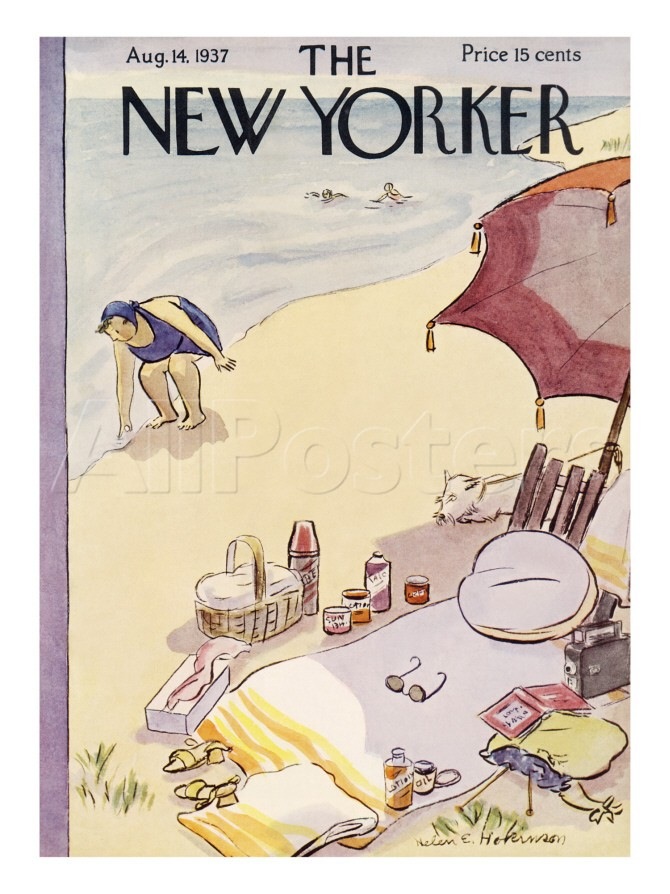
Women’s History month is wrapping up, but we at The Beat don’t feel we celebrated it properly, so for the next 24 hours most of the Beat staff is collaborating on “24 Hours of Women Cartoonists” to spotlight some of our favorite creators.
* * * *
First up:Helen E. Hokinson, a single panel cartoonist and illustrator from the mid 20th century — a period where the contribution of women to comics seems to have been mostly uncredited or in parallel fields such as picture books. The New Yorker of the period was not without female contributors, however, and among the most renowned was Hokinson (1893-1949) who contributed 68 covers and over 1,800 cartoons to The New Yorker. She was the definitive delineator of the stuffy Turtle Bay matron, a rarefied creature of habit and privilege. She was well known in her day producing half a dozen books of her own cartoons and illustrating many more. She died in a mid-air collision in 1949.
Hokinson’s reputation has perhaps suffered from reports that she illustrated staff captions rather than writing her own cartoons—a common practice at the time. There’s much more about her and other women cartoonists at The New Yorker in Liza Donnelly’s history book, Funny Ladies: The New Yorker’s Greatest Women Cartoonists And Their Cartoons
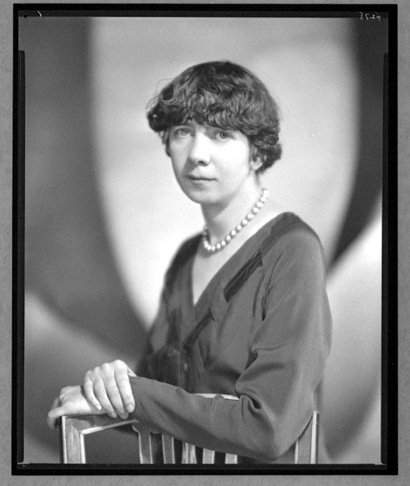
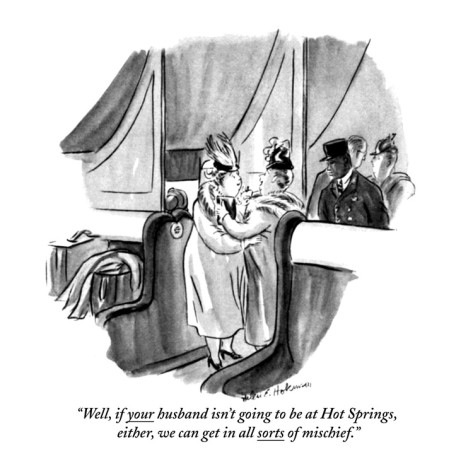
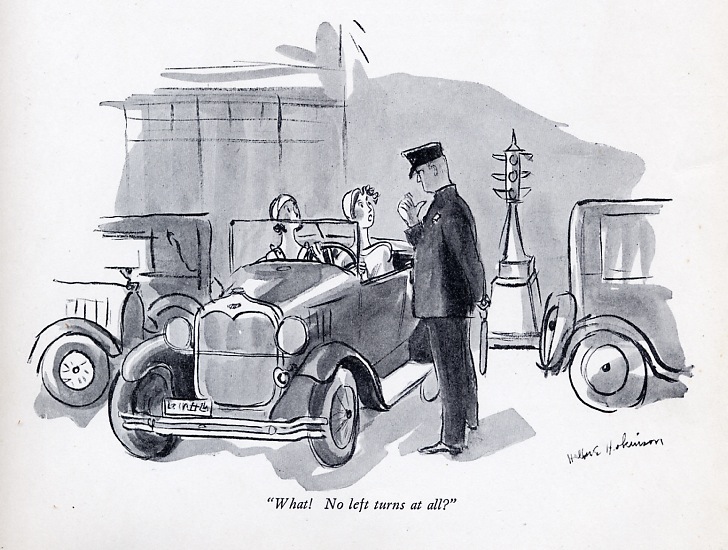



By:
Heidi MacDonald,
on 3/23/2013
Blog:
PW -The Beat
(
Login to Add to MyJacketFlap)
JacketFlap tags:
The Joker,
Carol Tilley,
Danny Fingeroth,
Denny O'Neil,
Seduction of the Innocent,
book-burning,
Dr. Frederic Wertham,
Heidi MacDonald,
James Reibman,
John Ordover,
Roy Thomas,
Sharon Packer,
Soho Gallery of Digital Art,
The Comics Code,
News,
Censorship,
Events,
History,
Comics,
Sociology,
DC,
Marvel,
Batman,
Joe Shuster,
David Hajdu,
psychiatrists,
Marvel Comics,
The Library of Congress,
DC Comics,
Craig Yoe,
Karen Green,
Top News,
Add a tag
As the first of several “Comic Book Roundtable” events to be held at the Soho Gallery of Digital Art under the auspices of gallery owner John Ordover and former Marvel editor, author, and educator Danny Fingeroth, this event exploring the life and legacy of Dr. Frederic Wertham was planned for the occasion of Wertham’s 118th birthday, but in the lead up to the event, recent developments in scholarship about the controversial comic reformer shed new light on the evening’s subject matter. In February 2013 Librarian, professor, and scholar Carol Tilley discovered, after examining Wertham’s papers held by the Library of Congress, that some of Wertham’s methods and reports were questionable, sparking debate in comics scholarship and among comics fans.

“Surely You’re Joking Dr. Wertham” hit the controversy head-on by bringing together a distinguished panel for discussion, including Tilley, comics writer, editor, and educator Denny O’Neil, author and educator David Hajdu, practising physician, psychiatrist, and author Sharon Packer, and author, editor, art director, and cartoonist Craig Yoe. The Soho Gallery provided excellent accompaniment to the event in the form of Wertham-related images and quotes displayed as a digital exhibit, and hosting a reception afterward.

The evening opened to a thoroughly packed-in audience, among whom were many scholars and authors who have shown a public interest in Wertham’s career and legacy, including James Reibman, the official Frederick Wertham biographer designated by Wertham’s estate. Host and moderator Danny Fingeroth provided an introduction to Wertham in the form of slides including pictures of Wertham in and out of official capacity as a clinical psychiatrist working with children, and also reminded the audience of the other books Wertham authored aside from his now legendary Seduction of the Innocent, a critique on the “influence of comic books on today’s youth”, published in 1954. This placed Wertham within the context of other cultural reactions of the time that questioned the sex and violence being depicted in comics as appropriate for young readers.
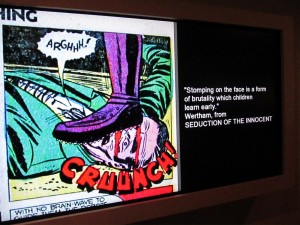
Tilley started off the panel discussion by explaining exactly what her recent research has uncovered about Wertham’s work. While her original intention was to locate materials relevant children’s education, she found “other things” that she didn’t expect to find among Wertham’s documents which she found “well-organized” in a “couple of dozen plus boxes” at the Library of Congress. The documents included copies of Wertham’s other research papers and speeches spanning his career, among which she found “discrepancies” and “some indication that he did things like combine the testimony of kids” or “broke apart” the testimony of one child “into four or five” in order to use quotes. This practice also resulted in evidence of “deleted or added” phrases from the children’s testimony that Wertham presented in Seduction of the Innocent and other works. This resulted, Tilley said, in a general “perception” of evidence in Wertham’s book that was “not the same as the actual case” of his research materials. When questioned about whether these changes were negligible or whether they altered the meaning of the children’s testimony, she confirmed that these “additions and word changes did change the meaning of testimony”. While Wertham’s book has often been criticized for its “lack of attribution” in footnotes or bibliography, Tilley feels that she has “seen personally” that his use of sources was not exacting enough. For those interested in Wertham’s legacy, this was something of a bombshell, though Tilley has been public about some of these findings previous to the evening’s discussion.
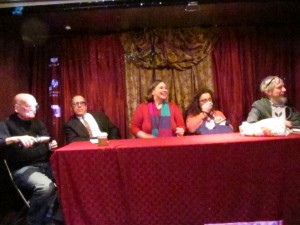
Hajdu then commented on Wertham as a figure, reminding the audience that Wertham is often a “handy symbol” of a wider movement against comic book excesses, and even a “personification” of the “cynicism toward comics in the late 40’s and 50’s”, even though he didn’t start this trend personally. Hajdu explained that even “newspaper comics incited criticism” prior to Wertham’s career and were often perceived as “crude, anti-literate” and examples of “defiant behavior” that raised public concern. The Catholic Church, particular, he noted, were active in inspiring state legislation against comics, due to their belief in the “power of aesthetics and the power of art” for both positive and negative influences on human behavior.
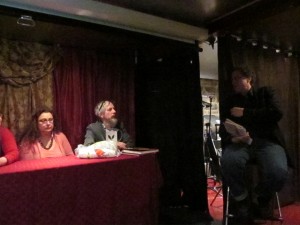
[Packer, Yoe, and Fingeroth]
O’Neil, himself raised Catholic, confirmed that his “first encounter with the (comic) witch hunters was in the pages of The Catholic Digest” and that he, as a young person “read and believed” that superhero comics, particularly, were potentially harmful. He related, to the audience’s amusement, that former Marvel editor Roy Thomas “as a kid” had participated in a book burning in Missouri where he “burned comics he was not interested in”, but rescued others he liked. Tilley briefly added that she had discovered evidence that librarians, too, had participated in comic burning and attempted to keep them out of libraries during this period because they were seen as “disruptive”.

Packer suggested that Wertham’s book title, Seduction of the Innocent, might have spoken particularly to a Christian demographic because of its suggestion of the massacre of the innocents by King Herod related in the New Testament of the Bible. This led to a reassessment among the panellists of Wertham’s title, since its original version was “All Our Innocents”. Fingeroth pointed out that this change made the title “very pulp sounding” and therefore more sensational.
Yoe’s background on the subject of juvenile delinquency as an author, and also his discovery of the “fetish art” of Joe Shuster confirmed that there were real-life implications for the more violent aspects of comic art, such as the case of the Brooklyn Thrill Killers who killed indigent people and molested women and when interviewed by Wertham as an expert witness, confessed to being inspired in their deeds by Shuster’s artwork. Yoe, however, prompted a wide-ranging and at times heated discussion on the subject of exactly how and when Wertham’s papers at the Library of Congress had been made available for research purposes. Both Yoe and Hajdu, upon requesting access in the past, had been denied use of the papers since they were “sealed” until the children who participated in the studies had passed away. “In many ways, I respect Dr. Wertham”, Yoe said, but “the Library of Congress is our library” and its contents “should be seen” regardless of the circumstances behind their compilation. Outspoken attendee and Wertham biographer Reibman, who was granted access to the papers at a much earlier date in order to work on his book, disagreed with Yoe’s statement in favor of “freedom of information”, arguing that sealing Wertham’s papers at the library was part of the “terms of the gift” to the library. Reibman’s frequent interjections on behalf of Wertham during the event contributed to a rather heated atmosphere.
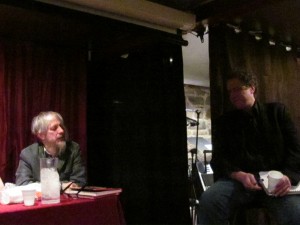
Yoe questioned further why some individuals, and not others, were then granted access despite the terms of the gift. Hajdu chimed in that he had requested access “dozens of times” but had been denied despite his academic credentials. Yoe asked Tilley if, based on her experience as a librarian, this discrepancy was “unusual” or not. Tilley confirmed that in her experience, the sealing of the papers while at the Library of Congress and then granting access to only those individuals sanctioned by the estate of the deceased, was indeed “unusual”. Attendee Karen Green, Graphic Novels Librarian at Columbia University, also commented that while “archives can be restricted”, for public documents this practice is “not usual”. Tilley provided further information about the situation by explaining that she was obliged to sign an agreement with the Library of Congress about the materials she accessed, even though a large portion of the Wertham papers consisted of “newspaper clippings” which “shouldn’t be restricted” anyway. Yoe brought some levity to the rapid fire questioning and often terse dialogue between he and Reibman by pointing out that Hajdu closely resembled a young Frederic Wertham and ought to have just turned up at the library, saying “I am here to see my papers”. Though Hajdu found the comparison amusing, he said “That’s the most offensive thing I’ve ever heard”.
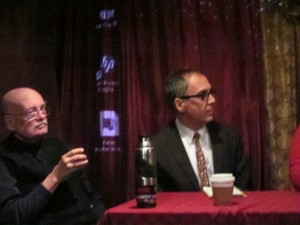
[O'Neil and Hajdu]
Fingeroth then gathered the reigns of the discussion as moderator to direct attention back to the panelists and away from the discursive arguments breaking out among audience members. Fingeroth asked O’Neil, specifically, if he had felt any “lingering hesitation” about comics after his experience with The Catholic Revue in childhood. O’Neil related that Wertham’s legacy, but particularly the Comics Code had impacted his career in comics. He was involved in “several public arguments” with administrators at comics publishing companies, wherein comics supporters felt the need to argue “comics are good, not evil anymore”. O’Neil’s personal feeling has always been, and still is, he said, that “If it’s censorship, it’s bad”, and often felt frustrated by the “vagueness of the language” in the Code itself, often leading comics creators to create elaborate avenues to get around the letter of the Code. He related a particularly frustrating incident where an IRONMAN story involving a “six story tall monster” crushing a police car was censored because it “showed disrespect to the police car” even though it also showed policemen being very brave in their fight against the monster. This kind of “idiocy” in the Code he particularly objected to, and added his motto that “blind worship of authority figures whether or not authority figures had any authority” should never be supported.
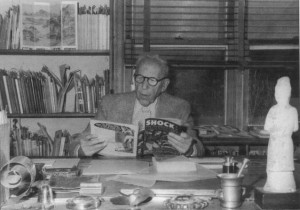
At this point, it was relevant to clarify that Wertham was not the founder of the Comics Code, though his work certainly paved the way for its development. Yoe reminded the audience that Wertham was, in fact, a progressive who was in support of the freedom of the press. It was more that Wertham “created the climate”, O’Neil supplied, which led to the Senate hearings, which led to the drafting of the Code. Both Yoe and O’Neil agreed that comics publishing was, in fact, in a very low economic position at the time of the Senate hearings anyway, due to the rise of paperback novel sales and TV watching. Yoe and O’Neil continued to discuss whether a “rating system” couldn’t have been created, rather than the unilateral Comics Code, in order to steer children away from more disturbing comics. Hajdu pointed out that the rating system was not in effect in Hollywood, by comparison, until the 1960’s, so there was not a particularly clear model to instate for comics at the time.

Fingeroth asked the panelists, and in particular, Packer, whether Wertham’s research was purely “anecdotal” or whether he furnished “hard statistics” when working with children. Packer provided some context as a clinical psychiatrists about the methods of the time during Wertham’s career. She compared Wertham to Sigmund Freud and pointed out that though “Freud was celebrated at that time”, “much of his original psychological literature” was “just as baseless” as Wertham’s methods. Tilley added that her survey of Wertham’s papers revealed that his “data was rich”, but it was just “how he used it rhetorically” that was “questionable”. Yoe commented that even though his rhetorical use of his data might lead us to view Wertham with increased suspicion, in the big picture, Wertham made a “pretty good case. Many comic books were not good for young children” in term of their content.

[Tilley and Packer]
Fingeroth took the question to a finer point. Did Wertham, he asked, in the opinion of the panelists, “take too many liberties” or not? Tilley stood her ground by asserting that “scientific investigation” requires accuracy, and a failure of accuracy is troubling from a scientist. Tilley added that her “personal sense” from working with the papers is that Wertham “cared more about getting rid of the comic book industry” than about his public cause of helping children develop in a psychologically healthy atmosphere. Though he certainly “cared for kids”, she reminded, she still felt that Wertham used children as “leverage” to achieve this greater goal of attacking the comics industry. One of the things that gave her a less than sterling impression of Wertham’s personality was discovering detailed transcripts that he “noted meticulously” of phone conversations that contained potentially harmful gossip about people who he saw as enemies in his career. He “collected information”, she said, “looking for weak spots” in the lives of people he wanted to undermine, particularly people who acted as “consultants for the comic book industry”.
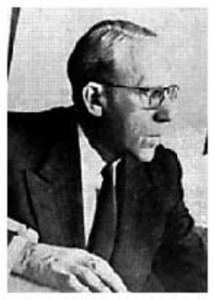
Fingeroth asked about Wertham’s movement, in his later career, toward criticism of the film industry and whether Wertham might have seen “comics as a stepping stone to a higher agenda” as a “career path”, but the general consensus among panelists seemed to be that comics were more easily attacked as a less profitable industry early in Wertham’s career, and that the tide of criticism had generally turned toward film around the time of Wertham’s developing interest in film. Film itself had, by the mid to late 60’s, become more overtly violent with works like Bonnie and Clyde.
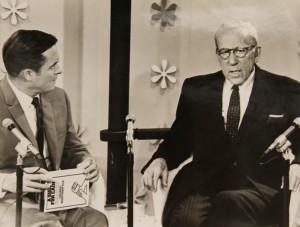
The rather charged atmosphere during the panel discussion gave way to an extensive question and answer period involving the audience and spanned a number of subjects. Did the distaste the comic book industry came to feel for Dr. Wertham result in a generally negative portrayal of psychiatry within comics? Yoe agreed that there are certainly plenty of “sinister psychiatrists” portrayed in comics tradition, and Packer supplied examples from Batman mythology including the Arkham family. O’Neil added that the character Harley Quinn was originally assigned to “cure” the Joker of his madness and instead was “driven nuts” herself. A more pointed question was posed about whether the possibility that Wertham skewed his evidence really made the questions he was asking about the role of comics at the time irrelevant. Hajdu fielded this question by commenting that the “weakest criticism of Wertham is that comics can’t affect minds and hearts”. As an art form, Hajdu argued, comics certainly do have impact and can “transform people”. “Comics have that power”, he reminded.

O’Neil weighed the issue by confessing that as a comics creator “You launch a given work and you have no way of knowing how it’ll bounce” and he often worried during his early career what impact particular comic stories might have on “kids already imbalanced”. O’Neil gave and example of his decision-making when he declined to include a “martial arts move” in one of his comics because it was “simple and damaging” and judged that kids might too easily learn to implement it. The audience, of course, immediately wanted O’Neil to demonstrate the deadly move, but he refrained in the interest of safety. For the same reason, O’Neil never allowed Molotov cocktails in his works, sure that it was too much of a “temptation” for kids to “see if it would work” building their own.

The Beat’s own Heidi MacDonald asked a rather burning question from the floor, one that continues to puzzle readers and comics historians alike: “Why do you think he attacked comics specifically? What did he hope to get out of it?”. The panelists answered in various ways. Yoe felt pretty strongly that Wertham was, in fact, motivated primarily by the fact that he “cared about kids” and was worried about the impact of comics. Packer analyzed Wertham a little by pointing out that Wertham himself, despite being married for many years, had no children of his own and this might have created a kind of “displacement” of concern for children that drove him to extremes. Hajdu simply stated that he felt Wertham to be “attracted to sensationalist cases” whether as an expert witness in extreme criminal cases or his research. He was, Hajdu said, a “publicity hound” at heart. Even Yoe added the admission that without a doubt Wertham had a “raging ego” driving his career.

Questions continued to circle back to the central role of Tilley’s new research on Wertham’s inconsistencies. How do we reassess Wertham based on the incorrectly conveyed details of his research, which clearly skewed his information in order to more sensationally and fundamentally support his thesis, when the “big picture” of his message, that extreme violence and sex in comics can be inappropriate for child readers, does seem sensible? Fingeroth presented a list of Wertham’s more “progressive” tendencies, stating that it’s possible to “go through a checklist of Wertham’s beliefs and agree except for comics” and respect many of his social contributions.
The final assessment of the panelists revealed some consensus out of a wide-ranging interrogation of Wertham’s method and legacy. O’Neil reminded the audience that Wertham was certainly not the “black-hearted villain” that many comics fans feel him to be, but he did detrimentally present those working in comics, “demonizing” them and making them out to be the “seducers and corruptors” of society, a crusade that damaged comics for decades to come. Yoe felt that the fundamental problem with Wertham’s whole approach to his subject was not necessarily the assumption that comics could be damaging to young minds, but that he “didn’t see that comics could be an art form”, and never commented on their positive potential as an “educational” resource. Yoe left the audience with the question, a lingering one, “Why couldn’t he see that?”. If Wertham had seen the potential of comics as a positive force, no doubt our current view of his work would also be more balanced on the whole.
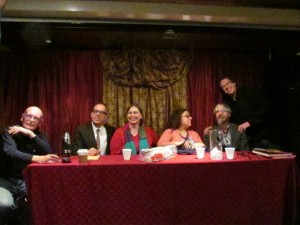
[The panelists and their moderator]
A predictably lively, but amicable, discussion period followed during the reception for the event, but if attendees expected definitive answers about the implications of Tilley’s new research on Wertham, they were left to their own devices. The panel discussion did provide solid context for Wertham’s life, work, and even a little for his motivations, as well as some solid information on what exactly Wertham’s failings as a researcher might be. Whether audience members were “pro-Wertham” or “anti-Wertham” initially, the discussion opened up new facets of his personality and work for further thought. Frederick Wertham may be less of a mystery now in the light of new research, but if anything, he’s even more of an enigma, confirmed as a complex figure. Learning more about Wertham changes perception of comics history, and that’s bound to change even more as scholars pay closer and closer attention to the records left behind in collections, personal archives, and thankfully, libraries.
The Comic Round Table events will continue this Spring at the SOHO Gallery for Digital Art with another hot topic in comics right now, the openly anti-gay position of Orson Scott Card and his work on SUPERMAN entitled “The Man of Steel vs. Orson Scott Card” on April 10th.
Hannah Means-Shannon writes and blogs about comics for TRIP CITY and Sequart.org and is currently working on books about Neil Gaiman and Alan Moore for Sequart. She is @hannahmenzies on Twitter and hannahmenziesblog on WordPress.
View Next 25 Posts































































I love Tuesdays at the Castle and really enjoyed Wednesdays in the Tower! They are some of my favorite books! Nice to see someone else liked them!
This one is high up on my TBR pile. Glad you liked it!!